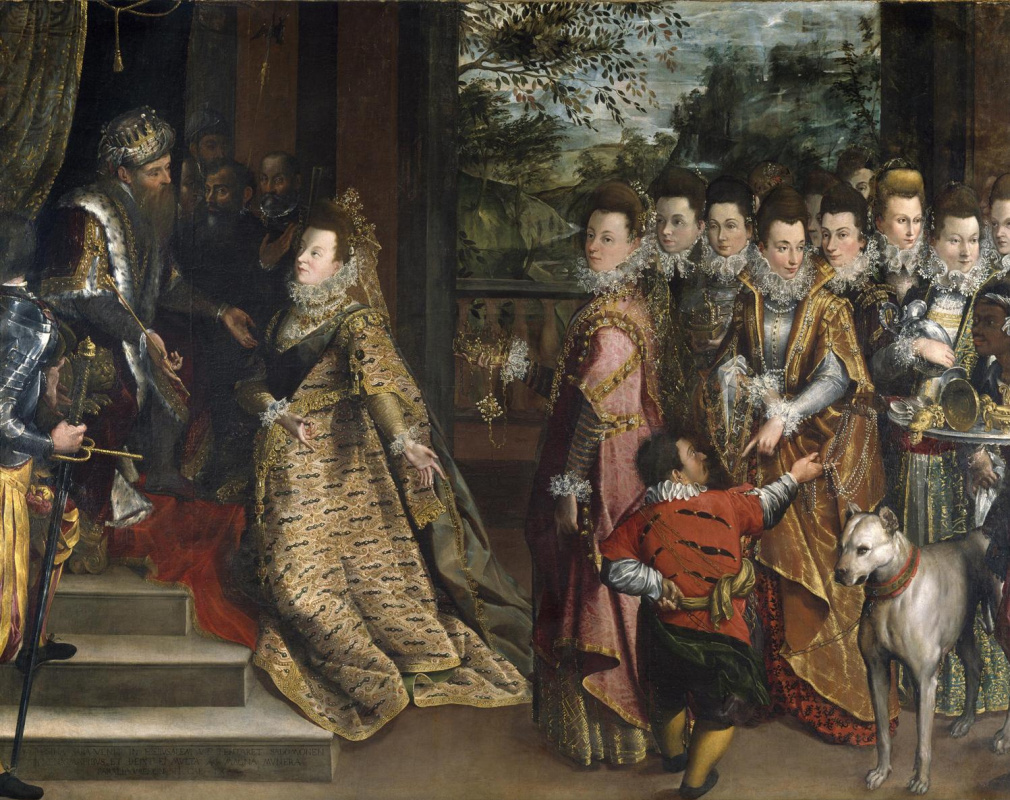Visita della regina di Saba al re Salomone
Descrizione del quadro «Visita della regina di Saba al re Salomone»
"The Queen of Sheba's Visit to King Solomon." is called the most ambitious of Lavinia Fontana's extant works (one hundred of her paintings are known from records, but only 32 have been reliably attributed to date). This canvas is a demonstration not only of the artist's skill, but also of her connections with the high society of late Renaissance Italy and a peculiar fashion show of the time.
Lavinia Fontana owes her success primarily to her father, the painter Prospero Fontana. He encouraged his daughter's interest in painting, was her teacher and first agent. Her parent also ensured that she received a brilliant education and arranged her marriage to a man who - contrary to tradition - agreed to move into his wife's home, took over the household and allowed her to develop her career.
Prospero also developed an advertising strategy for Lavinia that bore fruit: many of her early paintings were donated or sold at very low prices. As Caroline Murphy notes, the modest cost of the works, combined with the artist's talent, married status, erudition and education, attracted a wealthy clientele - "she became the preeminent portraitist of the elite of Bologna society.".
Fontana mostly painted women's portraits - apparently, female clients felt more comfortable posing for a female painter. She portrayed them at different moments in their lives, from engagement to pregnancy and even when they were mourning their deceased spouse. During her sessions, she formed warm and even friendly relationships with her clients. Many of them appear in the paintings as biblical and mythological characters, which, according to the artist, emphasizes their beauty and morality.
"The Queen of Sheba's Visit to King Solomon is one such example. The painting depicts Vincenzo I Gonzaga, Duke of Mantua, and his wife Eleonora de Medici, with her ladies-in-waiting standing behind her. This episode from the Old Testament was chosen because members of the Gonzaga family considered themselves descendants of the Queen of Sheba. Apparently, Lavinia Fontana painted this group portrait in 1600, when the ducal court stopped in her native Bologna on its way to Florence - for the wedding of their relatives Maria de' Medici and Henry IV of France.
This picture is also exceptional in that it has brought the idea of the clothing style of the time through the centuries to the present day. As fashion historian Jennifer Haraguchi notes, " defining Renaissance culture as a kind of "display," art historians explain that the social identity and prestige of the nobility depended on the stately display of elaborately made dress and jewelry. Many images in portraits and costume books provide clear evidence of the Renaissance nobility's desire to theatrically display their clothing and jewelry to the public.".
Lavinia Fontana followed this lavish tradition and took care to ensure that her patrons' most valuable assets were depicted in full glory (1, 2, 3). Even in biblical scenes, she clothed women in the most flamboyant outfits of her time, over the years honing tissue craftsmanship on the orders of her female clients. She shows old and new styles of gold patterned silk weaving.
As historian Carol Collier Frick writes, the painting "The Queen of Sheba's Visit to King Solomon" can be seen simultaneously "an earlier horizontal weave of silk, as well as a newer, diagonal weave, presented in a geometric pattern on the green and gold underskirt [of the first of the Maid of Honor]... A red silk fabric with a black floral pattern [on the next Maid of Honor], - perhaps a novelty in textile motifs, which is described in the documents as linea tronca or bastone rotto (interrupted line or broken stick).".
Lavinia Fontana portrayed her patrons, primarily the noblewomen of Bologna, as they wished to be seen. She emphasised their grandeur with sumptuous dresses, but for the artist - a zealous Catholic - the moral image of her sitters always came first. All the ladies in her portraits adhere to strict laws and regulations in their attire, which appear to have been abolished at the end of the Italian Renaissance.
It is worth noting that a number of costly paintings by Lavinia Fontana were for some time wrongly attributed to another Bolognese - her contemporary Guido Reni. The painting The Queen of Sheba's Visit to King Solomon was one of them.
Author: Vlad Maslov
UPD: interesting detail. According to the report published in the autumn of 2021 with the results of restoration, on the basis of the visible part of the painting (fragment with a clock) the date of creation of the work was clarified: 1599, not 1600, as previously thought.


